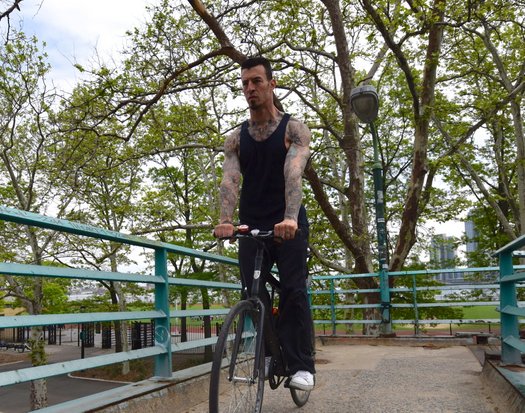
This past April, I was fortunate enough to attend the fifth Progressive Calisthenics Certification in Minneapolis, MN. I was a bit nervous about attending: I had recently undergone hand surgery, which kept me from working out for several months. Furthermore, just one month prior to PCC, I was diagnosed with a torn meniscus. At the age of 45, I was wondering if I was biting off more than I could chew. Leading up to PCC, I actually had dreams that would wake me at night of my knee giving out during the PCC’s final physical test, The Century…but luckily the knee held out and so did I!
As a police officer on a SWAT team, my fitness goals include getting in the best physical shape that I can and maintaining it for a lifetime. That means staying lean, strong, flexible and injury free. Unlike many commercial gym-goers, I don’t chase numeric goals or take expensive chemicals. I’m certainly not against mainstream fitness, but there is more to it to me than increased external poundage. Sadly, for a lot of people, it’s all too easy to get caught up in numbers or obsess over one single muscle. Many lose track of the purity of exercise and the unity of the human body, which is made to function as a whole.
Something I love about calisthenics is that just about all the moves require total body tension—elimination of perceived “isolation”. If you are questioning what I’m saying, try knocking out some one-arm pushups. If you can’t do them on the floor yet, then lean against a table, or even the wall, and try some. Seriously, go ahead and give it a shot! You will see that you MUST engage your whole body from your shoulder to your feet, or else you will end up in a twisted heap on the floor!
PCC helped me understand how bodyweight exercises can be adjusted in difficulty from beginner to advanced levels, even to the super-cool bodyweight feats of strength that Al and Danny Kavadlo are becoming famous for. Anyone can jump into the world of bodyweight training at whatever level is appropriate for them.
I’m finding a lot of people think PCC is just about learning some “cool” moves, but it’s much more. It’s learning techniques to use your body weight to do functional-type exercises and to be able to adjust the level of difficulty to fit a person at any fitness level – plus body weight exercises improve your body awareness, balance and flexibility.
 I love analogies. The following is how I see calisthenics:
I love analogies. The following is how I see calisthenics:
Calisthenic progressions can be compared to the use of a baby’s walker or even a circus performer’s unicycle, not to mention many things in between, all of which apply the principles of PCC. A baby’s walker is short and close to the ground, with several points of contact to the floor. This is similar to a modified push up on your knees – making the body shorter puts leverage in your favor, hence creating an easier regression. It is also similar to how a wide stance makes for an easier squat when compared to a narrow one.
Next, a toddler can progress to a tricycle – a little higher and with three points of contact. After a while, a child can ride a bicycle with training wheels – still three points of contact, but the points are closer together and the body is positioned higher, just like with the mighty pushup, which can be made easier by placing your feet farther apart and, conversely, tougher by bringing them together or even lifting one foot off the floor. Placing your feet on an elevated surface adds to the challenge as well.
Next is the classic bicycle. Even higher still, and with only two points of contact. A bicycle requires the rider to maintain balance. Many bodyweight exercises incorporate this element… Do you see a pattern? Handstands and Gecko Push-Ups are great examples of how balance affects the challenge. I tried and loved (and bought) a pair of Neuro-Grips at the PCC. If you really want to step up your game, try experimenting with push-ups, planks, or even L-Sits on these bad boys! You’ll see what I mean.

I believe anything is possible. If a person has the desire, they can progress to the unicycle, one-arm pull-ups, pistol squats, elbow levers, and more. Like a unicycle, there is only one point of contact in these advanced variations.
A person can approach any particular exercise and pick it up at an appropriate level for them. The exercises and all their variations continue to make me stronger, leaner and more flexible – plus I’m strengthening my joints which goes a long way towards injury prevention.
Although I was partially attracted to PCC because of how physically impressive some of the advanced moves are, I also took home more practical knowledge and experience than I could have previously imagined. With a Progressive Calisthenics Certification, I’m not just looking forward to sharing the information with others, I’m looking forward to having a great time doing it, which is also what it’s all about. Working out shouldn’t be a chore – it can be fun… just like riding a bike!

***
Wayne Salter served in the Army in the 82nd Airborne for four years and was a full time personal fitness trainer before becoming a police officer. He can be reached at: wayne0218@yahoo.com. He can also be reached through his website: www.exercise-guide-to-lose-weight.com